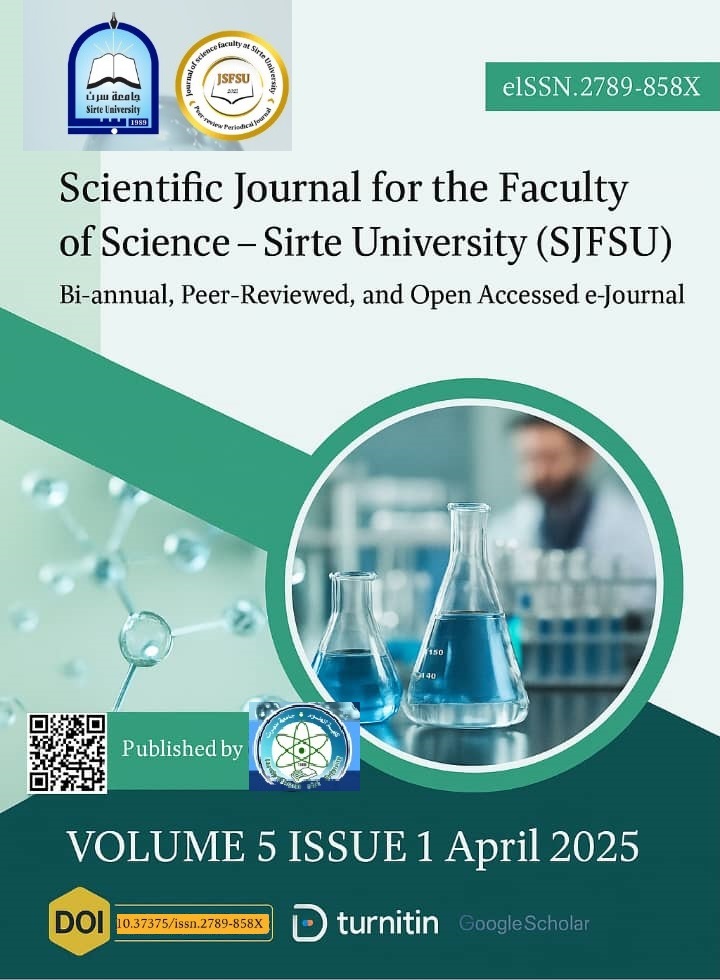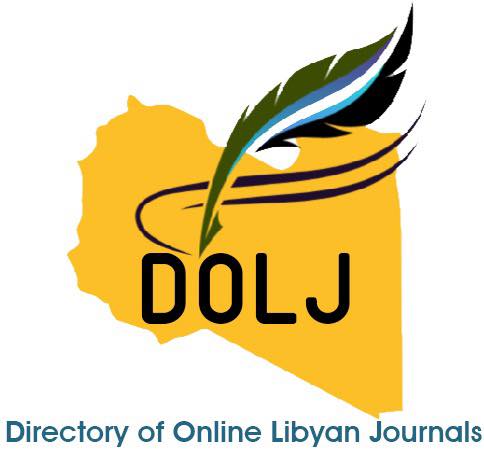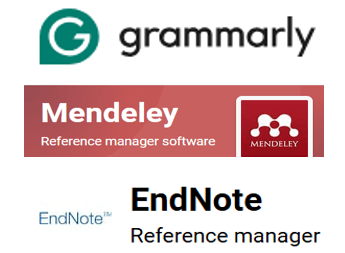Investigation of Sedimentary Microfacies and mineralogical analyses of the Coastal Rock Cliffs (Wadi al-Zaytoun) in the Al Jaghbub, Al Faidyah, and Abraq Formations, NE Libya
DOI:
https://doi.org/10.37375/sjfssu.v5i1.3080Keywords:
Wadi al-Zaytoun, Minerals, Facies, Dolomite and ForaminiferaAbstract
This study analyzes the bulk mineralogy and microfacies of the Al Jaghbub, Al Faidyah, and Abraq Formations, NE Libyaalong the Eastern Libya coastline using X-ray diffraction (XRD) on five samples from different geomorphological units. The results show a dominance of terrigenous minerals—mainly quartz, albite, and kaolinite—alongside carbonate minerals (calcite and dolomite) and evaporite minerals, particularly halite. Quantitative analysis reveals significant mineral proportion variations Al Abraq Formation contains high levels of dolomite (87.9%) and albite (7.9%), while Al Faidiyah Formation is predominantly calcite (98.9%). Halite appears in All Formations, indicating evaporative processes, and kaolinite in Sample 3 suggests fluvial influence or older sediment reworking. Microfacies analysis, conducted on thin sections from Wadi al-Zaytoun, identified five types: (1) dolomite wackestone, (2) foraminiferal bioclast packstone, (3) dolomitic wackestone, (4) foraminiferal bioclastic packstone, and (5) echinoidal, foraminiferal, algal packstone.
These microfacies display features indicating deposition in various environments, ranging from arid tidal flats to high-energy shallow marine settings. Diagenetic processes such as the replacement of micritic matrices with sparry calcite and the formation of coarse dolomite crystals highlight the roles of fluid migration and redox fluctuations.
References
Abdulsamad, E. O., Bu-Argoub, F. M., & Tmalla, A. F. A. (2009). A stratigraphic review of the Eocene to Miocene rock units in the al Jabal al Akhdar, NE Libya. Marine and petroleum geology, 26(7), 1228-1239.
Adam. A. A. F. (2018). Petrographically and Mineralogical Studies on the Oligocene-Miocene formations of Al Bardia Coastal Area, East Tobruk City, Libya. Unpublished M.Sc. Thesis, Mansoura University, Egypt 109 pp.
Banerjee, S., (1980). Cement grade limestones of Libya. Unpub. Rep., Industrial Research Centre.
Brown, G., (1972). The -X-ray Identification and Crystal Structures of Clay Minerals – Mineralogical Society. London.
Carver, R. (1971). Procedures in Sedimentary Petrology. Wiley Interscience, London, 441.
Chang, J. S., Yu, K.C., Tsai, L.J. & Ho, S.T. (1998). Spatial distribution of heavy metals in bottom sediment of Yenshui River, Taiwan. Water Sci. and Tech. 38 (11), 159-167.
Chao, G. Y., (1969). 2ɵ (Cu) table for common minerals: Geological.Carleton University, Ottawa, Canada,69-2.
Chen, P. (1977). Table of key lines in X-ray powder diffraction patterns of minerals in clays and associated rocks. Department of Natural Resources. Geological Survey. Occasional paper 21. Bloomington, Indiana, 67.
Dunham, R. J. (1962). Classification of carbonate rocks according to depositional texture. In: Ham, W.E. (Ed.), Classification of Carbonate Rocks. American Association of Petroleum Geologists, Memoir, 1, p108-121.
El Deftar, T., & Issawi, B. (1977) 'Geological map of Libya; 1:250,000. Sheet: Al Bardia NH 35-1. Explanatory Booklet', Industrial Research Centre, Tripoli, 93 pp.
El Ebaidi, S. K., Shaltami, O. R., Al Mahmoudi, A., & Fares, F. F. (2017) 'Geochemical Characterization of the Wadies (Al Hash, Al Shaigh, and Rahib), Tobruq-Burdi Area, NE Libya', Journal of Marine Sciences & Environmental Technologies, 3(1), E1-E17.
El Hawat, A. S., & Shelmani, M. A. (1993) 'Short notes and guide-book on the geology of Al Jabal al Akhdar, Cyrenaica, NE Libya', In Printed Limited Malta, pp. 70.
El-Ekhfifi, S, S., Abdulsamed, E, O., Mosa, K, A., and Alobaide. S. A (2017). Mineralogical and Foraminiferal Components of the Beach Sand of the Gulf of Tobruk, NE Libya: Environmental Implication. The second international conference on Geoscience of Libya. Abstracts, 43-44.
Embry, A. F., & Klovan, J. E. (1972). Absolute water depth limits of Late Devonian paleoecological zones. Geologische Rundschau, 61, 672-686.
Folk, R.,(1968). Petrology of Sedimentary Rocks. Hemphil Pub. Co., Austin, Texas, 184.
Industrial Research Center, 1977. Geological Map of Libya.
Khameiss. B., Muftah M., Muftah M., Abdelgalil M.,, (2024). Scleractinian Corals From the Benghazi Formation in As Sahabi Area and From Al Jaghbub Formation in Tubroq Area, Libya: Implications for Coral Diversity and Biogeography. The 14th ICEEE-2023 International Annual Conference Abstract and Proceedings Book, pp.313-324.
Lippmann, F., (1973). Sedimentary Carbonate Minerals. Springer Verlag, Berlin, 228pp.
Masoud, M & Khameiss, B. (2024). Mineral Composition of Coastal Landforms in Wadi Al-Suwani at Al-Bardia Region, East of Tobruk City, Libya. Scientific Journal for the Faculty of Science-Sirte University. 4(2), 15-32.
Masoud M, Anan,A., T., Mohamed, A & Gheith, A (2021). Microfacies Analysis and Depositional Environments of the Shahhat Formation, Tobruk Coast, Libya. Libyan Journal of Basic Sciences (LJ BC). 1(1), 1-11.
Masoud. A. M. M., (2020). Sedimentological and Environmental Studies on the Shore Zone of Tobruk City, Libya. Unpublished M.Sc. Thesis, Mansoura University, Egypt, 162.
Megerisi, M., & Mamgain, V. (1980) 'Al Khowaymat Formation - an enigma in the stratigraphy of northeast Libya', in Salem, M. J. and Busrewil, M. T. (eds.) The Geology of Libya, Volume 1, Academic Press, London, pp. 73-88.
Milliman, J., (1974). Marine Carbonates. Springer-Verlag, New York, 375.
Muftah, A. M., El Ebaidi, S. K., Al Mahmoudi, A., Faraj, F. H. and Khameiss, B. (2017). New insights on the stratigraphy of Tobruk - Burdi area-, NE Libya. Libyan Journal of Science & Technology, 6(1), 30-38.
Perrin, R. M. S. (1971). Classification of fine-grained sedimentary rocks. Journal of Sedimentary Research, 41(1), 179-195.
Pietersz, C.R., (1968). Proposed nomenclature for rock units in Northern Cyrenaica. In: Barr F.T. (Ed.), Geology and Archaeology of Northern Cyrenaica, Libya, Tripoli, pp. 125-130.
Rao, P.C. (1996). Modern Carbonates, Tropical, Temperate, Polar. Introduction to Sedimentology and Geochemistry. University of Tasmania, 206 pp.
Selley, R. C. (1968). A classification of paleocurrent models. The Journal of Geology, 76(1), 99–110. https://www.jstor.org/stable/30064946
Selley, R. C. (1967). Paleocurrents and sediment transport in nearshore sediments of the Sirte Basin, Libya. The Journal of Geology, 75(2), 215–223. https://www.jstor.org/stable/30066049
Reading, H. G. (1991). The classification of deep-sea depositional systems by sediment caliber and feeder system. Journal of the Geological Society, 148(3), 427–430. https://doi.org/10.1144/gsjgs.148.3.0427
Rohlich, P. (1974). Geological map of Libya; 1:250,000 sheet, Al Bayda sheet NI34-15, Explanatory Booklet. Indust. Resear. Cent., Tripoli, 70pp.
Tucker, M., (1988). Techniques in Sedimentology. Blackwell Scientific Pub., 38.

Downloads
Published
Issue
Section
License
Copyright (c) 2025 Scientific Journal for Faculty of Science-Sirte University

This work is licensed under a Creative Commons Attribution 4.0 International License.













